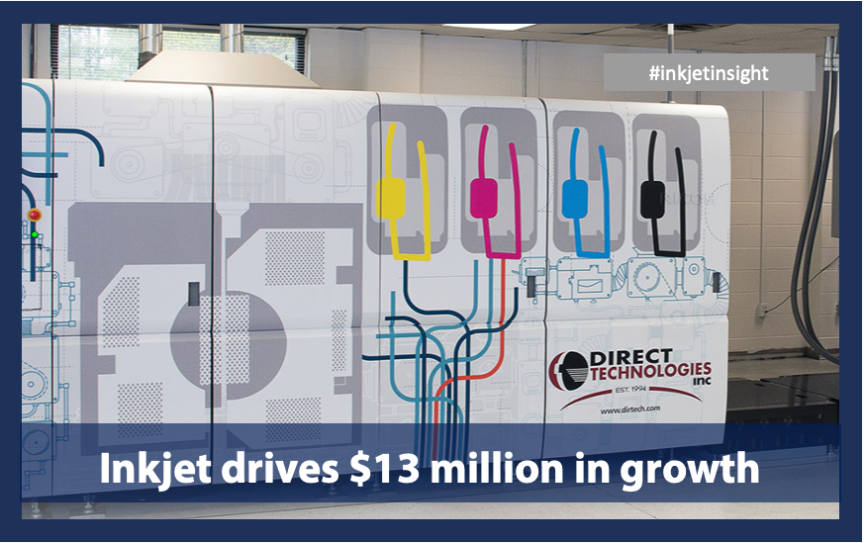New users of inkjet presses and inkjet early adopters alike are finding inkjet far more flexible than they anticipated. Inkjet quality levels and media compatibility are driving new opportunities. From transaction printing to signage, catalogs and magazines, inkjet is enabling opportunities for companies that are educated and prepared and keeping them stable in unpredictable times. Richard Hawes of Direct Technologies credits their investment in inkjet technology as key in their risk mitigation strategy and in enabling their growth opportunities. “With inkjet we had fewer operators needed when COVID hit,” Richard said. “Another benefit of going from 10 toner boxes to 2 toner and 3 inkjet was fewer base charges. Our base monthly equipment charges were cut in half. So if our business had slowed, as many company’s did in 2020, we would have had a lower financial hurdle to get over. ”
However, Direct Technologies in Suwanee, GA was among the lucky companies that actually experienced growth in 2020. Having the ability to handle more types of business was a bonus. Richard advises business owners to consider opportunity cost in addition to risk mitigation. “Make sure that you have the capacity for growth so you can bounce back to handle higher volumes. Don’t let your business decisions limit your ability to handle new business.” He notes that the horsepower of inkjet makes companies less reliant on labor to be able to grow and credits that flexibility with the ability to respond to opportunities related to political campaigns in 2020.
Direct Technologies started as a direct mailer of highly personalized marketing campaigns and has continued to grow enabled by new technology. Their foray into production inkjet came in the form of two Ricoh Pro VC60000 presses purchased as a means of lowering expenses for the client while maintaining a high color quality. Richard describes their investment as a “paradigm shift” that allowed them to deliver programs much faster at a significantly lower cost in a more controlled fashion. “Initially we leveraged our current accounts to give us new work that we could not be competitive on prior to inkjet. We added around 9 million dollars to our revenue the first year with higher than expected profitability,” said Richard. “But our sales people saw the opportunity to do even more.”
In the second year, Direct Technologies added 4 million dollars in revenue that came from new products such as personalized magazines, booklets, perfect bound books and tip-on matching cards. Consistent growth led them to invest in an inkjet press strictly for monochrome production. “We bought the mono press from Ricoh as we approached 80% capacity to free up capacity on the color presses, and also to run black and white work more profitably. Even after we shifted the volume off of the VC60000s, we kept growing and higher volumes continued to lower our average cost to print,” Richard told me. “We are running 24 hour shifts, 6 days per week and capacity is now back up to 70% across the three presses. We’re looking at a fourth press to expand our capabilities even further.”
Diversification of product types can provide opportunities for growth, but the ability to serve multiple application segments is another avenue for growth and stability. Direct Technologies’ fastest growing segments include Health Care, Finance, Insurance and Telecommunications, but they are present across a wide variety of industries. According to Richard, their diversification allows them to, “thrive in work that even when seasonal, uses the same process and production routines as other work. This way, we are able to thrive throughout the year as any individual industry has its high and low volume periods and our top 4 industry segments tend not to compete during their main seasons.”
Beyond the normal ebb and flow of seasonal volumes, the coronavirus pandemic drastically shifted supply and demand. Many vendors had to operate at lower capacity due to shortage of labor, but according to Richard, “We acquired quite a bit of new clients this last year due to their needs not being entirely met elsewhere.”
Although their overall number of presses and related overhead was reduced, Direct Technologies had to further invest in finishing technologies in order to maximize their success. According to Richard, “I had to bring up the entire shop to meet the capability of what the inkjet presses could do. New high-speed inserters were needed to produce 10 times the speed the old ones used to. If I walked into my shop now for the first time in 4 years – I wouldn’t recognize the place. Inkjet drove so many changes because it was so successful.” Overhauling a process is never easy, but with $13 million in new revenue in the first two years with inkjet, the benefits for Direct Technologies far outweigh the challenges.

